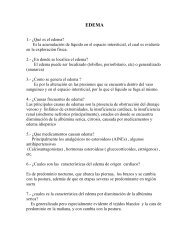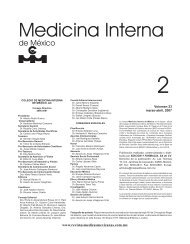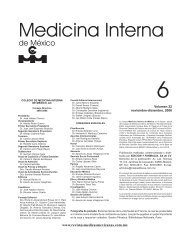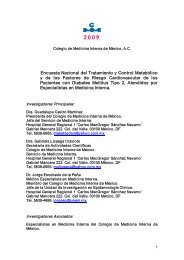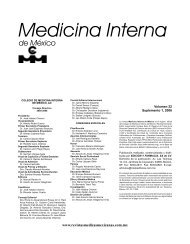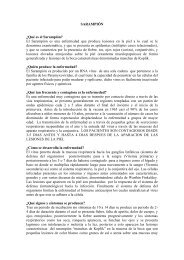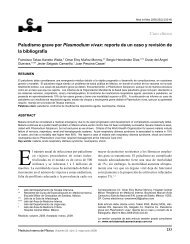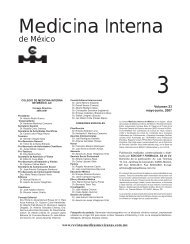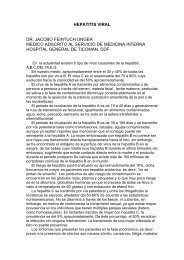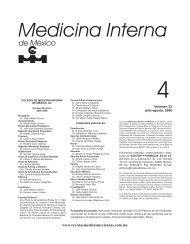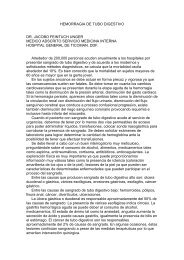Enero-Febrero - Colegio de Medicina Interna de México AC | CMIM
Enero-Febrero - Colegio de Medicina Interna de México AC | CMIM
Enero-Febrero - Colegio de Medicina Interna de México AC | CMIM
Create successful ePaper yourself
Turn your PDF publications into a flip-book with our unique Google optimized e-Paper software.
Efi cacia <strong>de</strong>l tratamiento con toxina botulínica tipo A en pacientes con migrañadoble ciego, controlado con placebo, en 123 pacientes,y observó que hubo disminución <strong>de</strong> más <strong>de</strong>l 50% enla frecuencia <strong>de</strong> los ataques <strong>de</strong> los pacientes que recibierondosis bajas <strong>de</strong> toxina botulínica. 18 Aunque hastael momento no se ha <strong>de</strong>terminado la dosis i<strong>de</strong>al parael tratamiento con toxina botulínica en pacientes conmigraña, se ha documentado que es preferible utilizar50 a 100 U por sesión, con aplicación en los puntosfrontales, interciliares, temporales y occipitales. Eneste estudio se administró una dosis <strong>de</strong> 100 U por sesión.No se registraron reacciones secundarias o efectosadversos <strong>de</strong>l medicamento. El corte se hizo en la primeraetapa, una vez que los 30 pacientes concluyeronel llenado <strong>de</strong> las escalas mencionadas. Los resultados<strong>de</strong>mostraron disminución <strong>de</strong> la escala <strong>de</strong> gravedad ytuvieron significado estadístico. El resto <strong>de</strong> los resultadoscareció <strong>de</strong> significado estadístico. Se apreció unimportante efecto placebo en la <strong>de</strong> gravedad, no asíen la <strong>de</strong> incapacidad, don<strong>de</strong> se observó disminución<strong>de</strong> casi 50% en los pacientes que tenían incapacidadinicial muy severa, esto en comparación con elgrupo placebo. En la actualidad se realiza un estudiocomplementario con cruzamiento <strong>de</strong> los grupos y enel que se establecen <strong>de</strong> nuevo las escalas aplicadasen este estudio, para conocer la eficacia <strong>de</strong> la toxinabotulínica como tratamiento preventivo. Debe reducirseel uso <strong>de</strong> tratamientos abortivos, con lo quedisminuiría el costo promedio <strong>de</strong> la enfermedad.Se concluye que la toxina botulínica tipo A es unmedicamento efectivo en el tratamiento preventivopara pacientes con migraña. Es <strong>de</strong> larga duración <strong>de</strong>acción, que pue<strong>de</strong> ser <strong>de</strong> tres meses o más, sin quese hayan observado efectos adversos o sistémicos. Serequieren más estudios para po<strong>de</strong>r <strong>de</strong>finir la dosis,la localización, el número <strong>de</strong> inyecciones, y la diluciónóptima <strong>de</strong>l medicamento. Debe especificarse siexisten otros tipos <strong>de</strong> cefalea que puedan reaccionara este tratamiento.REFERENCIAS1. Stane P, Osterhaus J, Celentano D. Migraine, patterns of healthcareuse. Neurology 1994;44:S47-S55.2. Hu X, Markson L, Lipton R, et al. Bur<strong>de</strong>n of migraine in theUnited States disability and economic costs. Arch Intern Med1999;159:813-8.3. Moskowitz M. The neurobiology of vascular head pain. Ann Neurol1985;16:157-68.4. Goadsby P, Shelley S. High-frequency stimulation of the facial nerveresults in local cortical release of vasoactive intestinal polypepti<strong>de</strong>in the anesthetised cat. Neurosci Lett 1990;112:282-9.5. Ramadan N, Silberstein S, Freitab T, et al. Evi<strong>de</strong>nce-basedgui<strong>de</strong>lines for migraine headache in the primary care setting:pharmacological management for prevention of migraine. 2000.www.aan.com/professionale/practice/gui<strong>de</strong>lines.cfm6. Brin M, Swope D, O’Brien C. Botox for migraine: double blind, placebo-controlled,region-specific evaluation (abstract). Cephalalgia2000;20:421.7. Mauskop A, Basedo R. Botulinum toxin A is an effective prophylactictherapy for migraine (abstract). Cephalalgia 2000;20:422.8. Erbguth F, Naumann M. Historical aspects of botulinum toxin:Justinus Kerner (1786-1862) and the “sausage poison”. Neurology1999;53:1850-3.9. Jankovic J. Botulinum toxin in clinical practice. J Neurol NeurosurgPsychiatry 2004;75:951-7.10. Dodick D. Botulinum neurotoxin for the treatment of migraine andother primary headache disor<strong>de</strong>rs: from the bench to bedsi<strong>de</strong>.Headache 2003;42(Suppl 1):S25-S33.11. Brin M. Treatment of dystonia. In: Jankovic J, Tolosa E, editors.Parkinson’s disease and movement disor<strong>de</strong>rs: New York: Williams& Wilkins, 1998;pp:553-78.12. Black J, Dolly J. Selective location of acceptors for botulinum toxinA in the central and peripheral nervous system. Neuroscience1987;23:767-79.13. Suzuki N, Har<strong>de</strong>bo J. Neuropepti<strong>de</strong> Y coexists with vasoactiveintestinal polypepti<strong>de</strong> and acetylcholine in parasympathetic cerebrovascularnerves originating in the sphenopalatine, otic andinternal carotid ganglia of the rat. Neuroscience 1990;36:507-19.14. El Hasnaoui A, Vray M, Richard A, et al. Assessing the severityof migraine: <strong>de</strong>velopment of the MIGSEV scale. Headache2003;43:628-35.15. Wagner T, Patrick D, Galer B, et al. A new instrument to assessthe long-term quality of life effects from migraine; <strong>de</strong>velopment andpsychometric testing of the MSQOL. Headache 1996;36:484-92.16. Stewart W, Lipton R, Whyte J. An international study to assessreliability of the Migraine Disability Assessment (MIDAS) score.Neurology 1999;53:988-9.17. Blumenfeld A. Botulinum toxin type A as an effective prophylactictreatment in headache. Presented at 6 th Headache Congress ofthe European Headache Fe<strong>de</strong>ration. June 26-30, 2002; IstanbulTurkey. Abstract 81.18. Silberstein S, Mathew N, Saper J, et al. Botulinum toxin A as amigraine preventive treatment. For the Botox Migraine ClinicalResearch Group. Headache 2000;40:445-50.19. Headache classification committee of the <strong>Interna</strong>tional HeadacheSociety. Classification and diagnostic criteria for headache disor<strong>de</strong>rs,cranial neuralgias and facial pain. Cephalalgia 1988;(Suppl7):1-96.<strong>Medicina</strong> <strong>Interna</strong> <strong>de</strong> <strong>México</strong> Volumen 22, Núm. 1, enero-febrero, 200631



